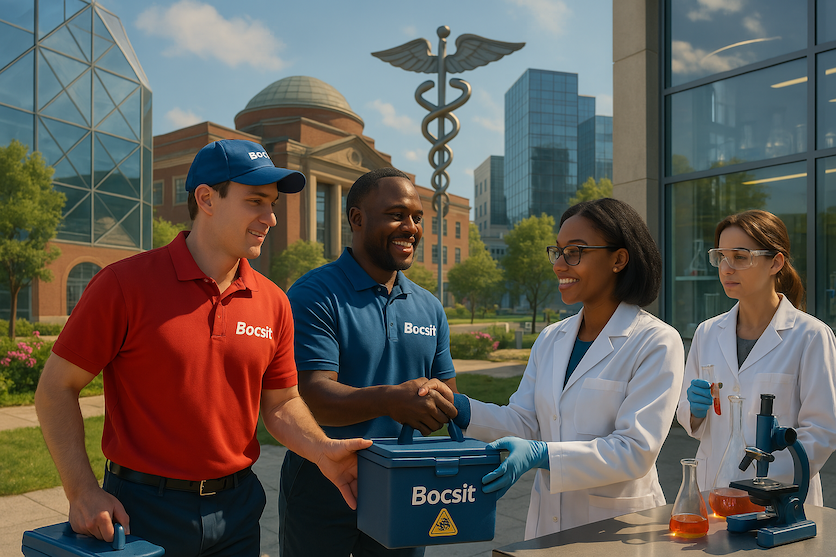Revolutionizing Healthcare: The Emergence and Impact of Direct-to-Patient Logistics

In the rapidly transforming world of healthcare, the introduction of Direct-to-Patient (DTP) logistics marks a revolutionary shift, redefining conventional healthcare delivery methods. This groundbreaking approach, though still relatively new to many organizations, holds immense potential for creating a more efficient supply chain, significantly impacting patient care and the pharmaceutical landscape.
This article dives into the essence of DTP logistics, shedding light on its critical role in clinical trials, medication delivery, and enhancing patient engagement.
Understanding DTP Logistics: A Game Changer in Healthcare
Clinical trials, a critical phase in drug development, often face significant challenges, including high costs and extended timelines. According to World Pharma Today, testing a single drug can cost around $2.6 billion. This not only impacts the revenue of pharmaceutical companies but also slows down medication availability for patients in need.
In the context of general healthcare, accessibility remains a challenge in the United States. About 40% of people might skip medical tests or treatments due to the inconvenience of reaching healthcare facilities. Additionally, an estimated 100 million Americans have limited access to pharmacies and medical supplies.
Enter DTP logistics: a strategy that brings medications, medical supplies, and clinical trial necessities directly to patients' homes. This approach ensures accessibility and convenience, revolutionizing the pharmaceutical industry and the nature of patient care.
Direct Patient Care: Transforming the Healthcare Experience
DTP logistics signifies a shift in the healthcare paradigm, particularly in patient care. Traditionally, patients had to navigate complex clinical environments, often leading to administrative hassles and interrupted care. This often resulted in premature treatment cessation, with dire consequences.
DTP logistics, however, brings healthcare services to patients' doorsteps, altering patient interaction dynamics and emphasizing ease, accessibility, and personalized care. It enhances patient experiences and healthcare outcomes, as patients no longer face the inconvenience of travel or disruption to their daily routines. This approach, central to the DTP framework, not only ensures better healthcare delivery but is deeply patient-centric.
Direct Patient Care Forms
Home Healthcare Services: A broad range of medical care provided at the patient's residence.
Telehealth and Telemedicine: Virtual consultations and monitoring for accessible healthcare.
Direct-to-Patient Medication Delivery: Ensuring medication adherence by delivering directly to homes.
Direct-to-Patient Clinical Trials: Streamlining clinical research by delivering study drugs and assessments to participants.
Mobile Health (MHealth) Services: Apps and devices for self-management and remote monitoring.
Benefits of Direct-to-Patient Logistics
- Enhanced patient adherence through direct home delivery.
- Improved accessibility, especially in remote or underserved areas.
- Increased patient satisfaction due to the convenience of home healthcare.
- Efficient and cost-effective clinical trials.
- Flexible and patient-centric care models.
- Optimized healthcare operations.
- Effective response in public health emergencies.
Challenges in DTP Logistics
Implementing DTP logistics faces challenges like temperature-sensitive drug transportation, privacy concerns, tracking and monitoring complexities, regulatory compliance, logistical coordination, varying regional willingness, and patient compliance and monitoring.
Innovations in Direct-to-Patient Services
- Advanced Telehealth Technologies.
- IoT and Smart Devices.
- AI and Predictive Analytics.
- Blockchain for Secure Data Management.
- Drones for Medication Delivery.
- Digital Therapeutics.
- Enhanced Remote Monitoring Devices.
- Personalized Medicine Solutions.
Leading Companies in DTP Logistics
Bocsit stands out for its exceptional same-day delivery services in healthcare logistics, offering unparalleled efficiency and reliability. Specializing in pharmaceutical shipping, blood and specimen transportation, and cold chain logistics, Bocsit ensures secure and timely delivery, emphasizing customer satisfaction through real-time tracking and flexible logistic solutions.
Other notable companies include Clinerion and Marken, each bringing unique strengths to the DTP logistics landscape.
Final Thoughts
Direct-to-patient logistics is not just a logistical evolution but represents a seismic shift in healthcare delivery. With leaders like Bocsit paving the way, the future of healthcare logistics is bright, promising a patient-focused, efficient, and secure method of delivering healthcare services.
FAQs
What is DTP in healthcare logistics?
DTP stands for Direct-to-Patient, a logistics model that delivers supplies and medications directly to patients' homes, revolutionizing clinical trials and healthcare delivery.
How does DTP improve healthcare accessibility?
DTP logistics facilitates healthcare services directly to patients' homes, overcoming geographical barriers and ensuring accessibility even in remote areas.
What are the main benefits of DTP logistics?
The benefits include enhanced patient adherence, improved accessibility, increased patient satisfaction, cost-effective clinical trials, patient-centric models, optimized operations, and effective response in emergencies.


















